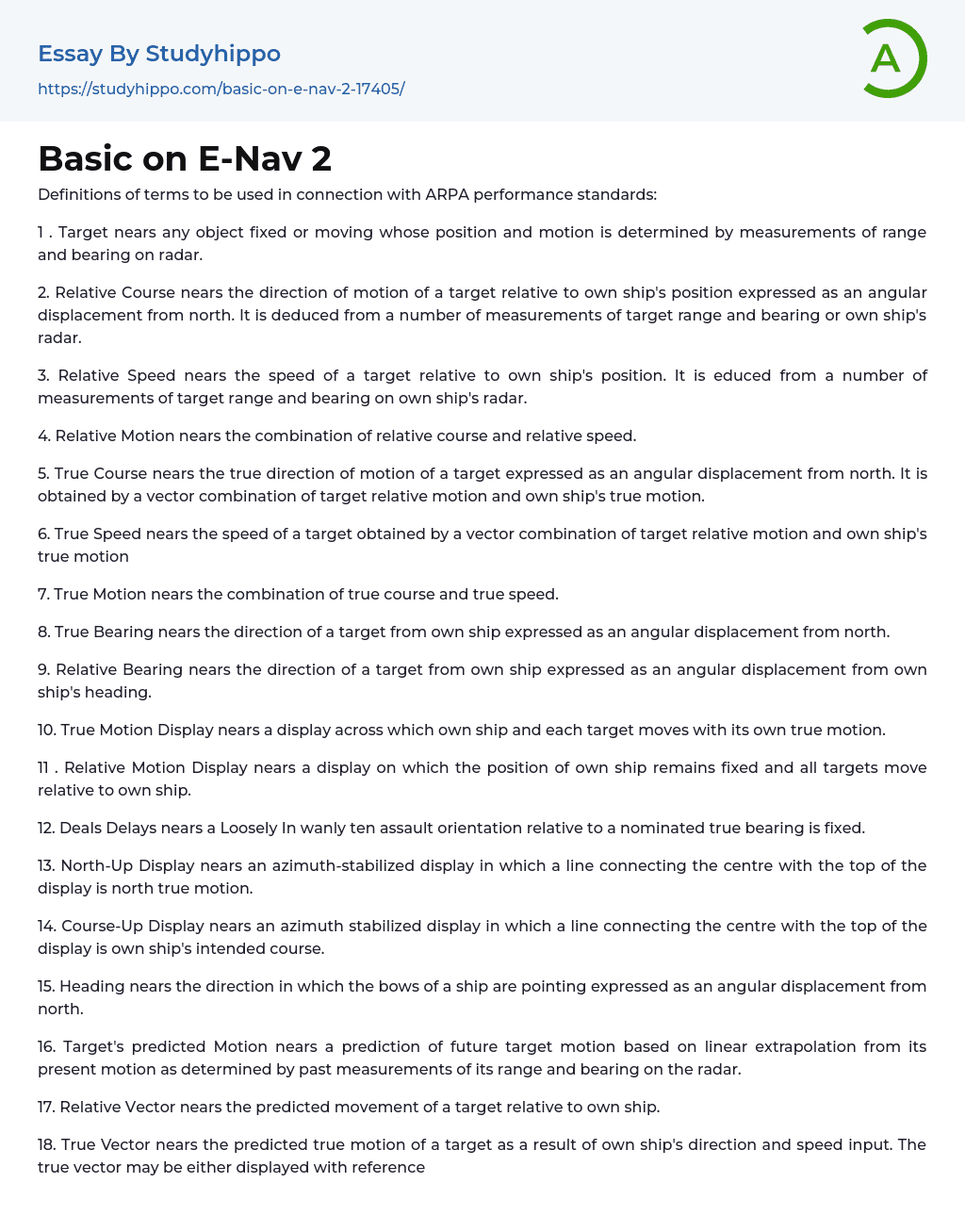The following are definitions of terms that will be used in relation to ARPA performance standards.
1. A target refers to any object, whether stationary or in motion, that can be located and tracked using radar measurements of its distance and direction.
Relative Course indicates the direction in which a target is moving relative to the position of the own ship. It is determined based on measurements of target range and bearing, or the radar of the own ship.
3. The speed of a target relative to the position of the own ship can be determined by taking measurements of the target's range and bearing on the radar.
Relative Motion involves the combination of relative course and relative speed.
The true course is a representation of the target's true direction of motion with respect to an angular displa
...cement from north. This is determined by combining the target's relative motion with the true motion of the own ship.
True Speed approximates the speed of a target acquired through a vector combination of the target's relative motion and the own ship's true motion.
7. True Motion is approaching the fusion of true course and true speed.
8. True Bearing refers to the angular displacement from north that indicates the direction of a target relative to own ship.
9. Relative Bearing refers to the direction of a target from the own ship and is expressed as an angular displacement from the own ship's heading.
10. The True Motion Display is approaching a display in which own ship and each target move with their respective true motions.
11. Relative Motion Display refers to a display where th
position of the own ship remains fixed, and all targets move relative to the own ship.
12. Delays in deals are approaching a loose orientation towards a nominated true bearing that remains fixed.
13. The North-Up Display is an azimuth-stabilized display where the top of the display represents north true motion.
14. The Course-Up Display is an azimuth stabilized display that shows a line connecting the center with the top of the display, representing own ship's intended course.
15. The heading refers to the direction that the bows of a ship are pointing with an angular displacement from north.
The expected future movement of Target is nearing its prediction based on linear extrapolation from its current motion, as determined by previous radar measurements of range and bearing.
17. The Relative Vector is approaching the anticipated movement of a target in relation to our own ship.
18. The true vector of a target is approaching as a result of own ship's direction and speed input. It can be displayed with reference to either the water or the ground.
19. The acquisition process involves choosing a target or targets and beginning to track them.
Tracking is the computer process whereby the sequential changes in a target's position are observed to determine its motion.
Target Swoop is approaching a scenario where the radar data of a tracked object is mistakenly linked to another tracked object or an untracked radar reflection.
The Acquisition Area is a designated space near an observer's arena, designed to automatically acquire a target when it enters this area.
23. The history of a target being tracked can be either relative
or true, and it closely aligns with the target's past time and position.
24. The radar echoes of targets create trails that appear as synthetic afterglow. These trails can be either relative or true.
25. The true trails can either be at sea or on the ground, and each reference provides a way to indicate that a specific fixed navigational ark, which is being tracked, should be used as a ground stabilized reference. This is necessary for the purpose of loosening tension and achieving stability both at sea and on the ground.
Trail Maneuver is a facility that helps the observer make the right maneuver for navigation and avoiding collisions.
27. The suppressed area approaches the area established by the observer where targets are not acquired.
28. The REBEL is approaching the electronic range and bearing line that is used for measuring bearings and ranges.
The terms CPA/TCP refer to the limits of closest point of approach (CPA) and time to closest point of approach (TCP) from our own ship, as defined by the observer. These limits serve as a warning for when a tracked target or targets will approach within those limits.
- Smartphone essays
- Cell Phones essays
- Camera essays
- Computer essays
- Ipod essays
- Mobile Phones essays
- 3g essays
- Bluetooth essays
- Cell Phones in School essays
- Computer File essays
- Desktop Computer essays
- Servers essays
- Cloud Computing essays
- Computer Science essays
- Consumer Electronics essays
- Data Analysis essays
- Electronics essays
- engineering essays
- Enterprise Technology essays
- Hardware essays
- Impact of Technology essays
- Information Age essays
- Information Technology essays
- Modern Technology essays
- Operating Systems essays
- people search essays
- Robot essays
- John Locke essays
- 9/11 essays
- A Good Teacher essays
- A Healthy Diet essays
- A Modest Proposal essays
- A&P essays
- Academic Achievement essays
- Achievement essays
- Achieving goals essays
- Admission essays
- Advantages And Disadvantages Of Internet essays
- Alcoholic drinks essays
- Ammonia essays
- Analytical essays
- Ancient Olympic Games essays
- APA essays
- Arabian Peninsula essays
- Argument essays
- Argumentative essays
- Art essays
- Atlantic Ocean essays
- Auto-ethnography essays
- Autobiography essays




